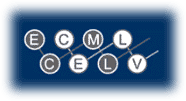
Interview with Mr. Lukas Wertenschlag,
co-author of Profile Deutsch and of numerous textbooks
for German as a foreign language
Laura Muresan
![]()
Laura Muresan: What is the role of Profile Deutsch in relation to the Common European Framework?
Lukas Wertenschlag: Profile Deutsch is the first concrete application of the Common European Framework to one language. A team of five, we have worked on it for some 3 ½ years, we have carefully read and analysed the CEF, and have considered which parts of it lend themselves to a concrete realization. This was also the task we had from the Council of Europe: to transpose what is applicable in concrete terms to a single language. We have taken the 'can-do' statements and tried to complete the section on 'Mediation' from level A1 to level B2, something which is missing in the CEF. We have then approached the learning strategies and the communication strategies, which are only suggested in the CEF, and have developed that whole part and have added on a concrete dimension; and there is, of course, the whole area of linguistic means - vocabulary, structures, grammar - and what I consider of particular importance, the approach to text types...
Why have we done this? 'Die Kontaktschwelle' ('the Threshold level') had to be revised, to be updated, so that we have decided to find a technologically modern version, i.e. available not only as book, but also as an open system available on CD ROM ...
Profile Deutsch - entirely in the spirit of the Common European Framework - are intended to provide a framework, where the user can enter his/her own examples of language use corresponding to the 'can-do' statements or add relevant items of vocabulary, learning strategies, grammar. This is in the spirit of the Council of Europe philosophy: to provide a framework, an instrument, that can be applied and adapted according to region, country, situation.
LM: How do you see the link between 'Reference levels', 'language profiles' and quality assurance?
LW: The Reference levels are an important instrument, a catalyst of different interests and needs, an important communication instrument between teacher and institution, between learner and teacher. If these levels are taken seriously, then the school or institution will be required to re-think certain aspects, especially in the area of teaching practice and communication with the customers. This instrument is particularly useful in customer-oriented communication; it can help formulate clear objectives that offer a transparent and coherent overview of school processes, e.g. regarding syllabus, customer information, etc. In relation to international diplomas, that have already been aligned to the reference levels, the school - whether in the state or the private sector - has to adapt the teaching/ learning objectives to international diplomas and to structure the teaching process accordingly, if it wants to stay successful.
In the companies, it helps make language requirements from staff more transparent. Staff members had to know, for instance, a language, but nobody knew what this really meant. With the help of the CEF, it is now easier to define these requirements.
Here is an example, a case study from Switzerland:
We have provided consultancy to the Swiss Railway Company (SBB / die Schweizerischen Bundesbahnen) for the introduction of language profiles for certain staff categories: employees at the counter and conductors. We didn't carry out the needs analysis with language specialists, but with the people in the company. They themselves indicated what language profile they needed, and then - with the help of software - we designed the profiles according to the reference levels. This is not a monolithical profile; depending on concrete language activities and skills, the requirements within a profile are differentiated. An important novelty consists in making it possible to a larger extent to have differentiated, realistic profiles as compared to what was previously possible and feasible.
LM: How can the 'profiles' work as a quality assurance instrument in the company?
LW: The SBB, for instance, has outsourced the language training, transferring it to private language providers. Thanks to the language profiles, the language providers/schools know exactly what they have to offer. They have now a clearer 'profile' that they can use to design specific courses for certain target groups. In the relationship with the outside world, this is a guarantee that the company and its staff will be receiving what they need. At the same time, the company can check whether staff members can do what they are expected to. This check can be done through self-declaration - the learners say "I can do this …", or through evidence of having attended a course, or through international diplomas, that are recognized as an equivalent of this 'profile'.
Moreover, the SBB want to increase staff self-responsibility for their language learning. The company, therefore, offers its staff 'Lingua-cheques' up to a certain amount. Everybody can cash them personally, in order to use that amount for a language course or another language experience. An effective way of motivating people!
